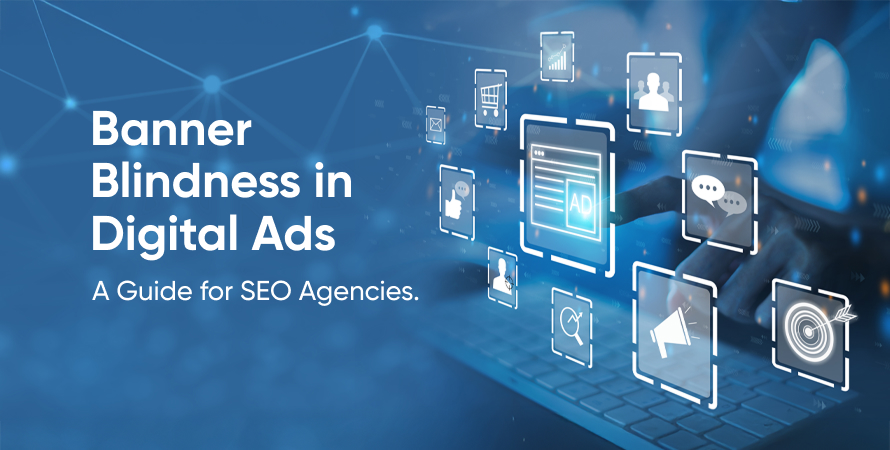Banner Blindness in Digital Ads: A Guide for SEO Agencies



As digital marketing evolves, many strategies that once worked effectively now face diminishing returns. One such phenomenon is banner blindness. It’s a growing concern in today’s marketing landscape, especially for agencies that rely on banner ads to drive results for their clients.
At White Label SEO Providers, we work closely with agencies to improve campaign performance across multiple channels. One of the most overlooked hurdles in banner advertising is that users often don’t even notice the ads and banners placed right in front of them.
This blog explains what banner blindness is, why it matters, and why agencies must rethink their approach to advertising banners if they want to deliver real ROI for their clients.
What Is Banner Blindness?
Banner blindness refers to a user behavior where people subconsciously ignore advertisement banners or any elements on a webpage that resemble ads. The term was first coined by web usability expert Jakob Nielsen, who discovered that users tend to filter out content that looks like advertising—regardless of its relevance.
This isn’t limited to ad banners alone. Even important call-to-actions or promotional content can be overlooked if they visually resemble advertising old formats. Over time, internet users have become highly adept at tuning out these visuals, making many traditional banner ad campaigns far less effective than they appear on the surface.
For agencies handling client campaigns, this means that simply increasing ad impressions isn’t enough. If the audience doesn’t consciously see the advertising banner, it won’t drive engagement or conversions.
Why Banner Blindness Happens
Understanding the cause of banner blindness is essential for agencies and SEO professionals aiming to improve client outcomes. Here are the key reasons it occurs:
1. Overexposure and Ad Fatigue
Internet users are bombarded with thousands of visuals daily. The constant exposure to ads and banners across websites and apps leads to cognitive filtering. People learn to ignore anything that looks promotional by default.
2. Poor Ad Design
When an advertising banner is flashy, intrusive, or poorly aligned with the page’s layout, users instantly categorize it as non-essential. A typical example would be a banner ad with loud colors or aggressive calls to action—elements users have been trained to avoid.
3. Bad Placement
Placing an advertising banner in areas users rarely look at—such as sidebars or footers—limits its visibility. Heatmap studies consistently show that users focus on content zones, not traditional ad slots.
4. Irrelevant Messaging
If your advertisement banner doesn’t align with user intent or the context of the page, it feels out of place. Even well-designed ads fail when they aren’t relevant.
5. Device Behavior Differences
Mobile users scroll quickly and spend less time on visual elements that appear at the top or bottom of a screen. In contrast, desktop users may interact differently. Not accounting for this discrepancy can worsen the problem.
This growing indifference to display advertising poses a real threat to agency-client campaign success if not addressed thoughtfully.
How Banner Blindness Hurts Your Clients’ Campaigns
Ignoring the effects of banner blindness can silently drain your clients’ ad budgets and hinder long-term performance. Below are some of the major ways it can impact digital campaigns:
1. Drop in CTR and Engagement
Even if a banner ad is technically visible, users may scroll past without acknowledging it. This leads to extremely low click-through rates (CTR), which misrepresent the ad’s effectiveness.
2. Misleading Metrics
Just because a platform reports high impressions doesn’t mean those impressions resulted in actual visibility. Impressions can give a false sense of reach when users are simply ignoring the ads and banners altogether.
3. Budget Waste
Agencies may continue investing in display advertising without realizing the return is minimal. Poorly placed or outdated advertising banners can deplete ad budgets while delivering little to no value.
4. Low Trust and Brand Disconnect
A client’s brand suffers when ad banners are consistently ignored or viewed as spammy. Users develop a negative association with the brand, especially if the design feels pushy or irrelevant.
5. Long-Term Conversion Decline
As audiences become conditioned to ignore ads, the opportunity for conversion drops. If your agency relies on display advertising for traffic, this behavior can directly impact sales and lead generation.
For agencies that want to maintain a competitive edge, addressing these issues is crucial. At White Label SEO Providers, we guide partner agencies to rethink their visual advertising strategies in a way that prioritizes human behavior, not just impressions.
To ensure your entire marketing funnel aligns effectively, we also recommend exploring how to optimize your content for Google’s featured snippets, which can complement ad visibility with organic authority.
Signs Your Clients Are Suffering from Banner Blindness
Before agencies can fix the problem, it’s important to recognize the red flags of banner blindness. These subtle indicators often go unnoticed, yet they directly impact campaign success. Here’s what to look for:
1. CTR Below Industry Benchmarks
If your client’s web banner ads consistently fall below expected click-through rates, it may not be because the offer is weak—it could be that users simply aren’t seeing the ads on banner placements at all.
2. High Bounce Rates on Ad Landing Pages
You might notice that users are clicking but leaving immediately. This could stem from a disconnect between the advertise banners and the landing page experience. More likely, though, only the most engaged users even interact with banner advertisement elements.
3. No Change After A/B Testing Visuals
If you’ve tested different creatives, CTAs, or placements and nothing moves the needle, it’s a strong sign of ad blindness. Your users may have become so conditioned to ignore website ad banners that no design alone can cut through.
4. Scrollmaps & Heatmaps Show Cold Zones
Tools like Hotjar or Crazy Egg can show whether users are scrolling past your banner for advertisement sections without engaging. Cold zones in these maps often indicate ignored placements, which is common in blind advertising scenarios.
5. Engagement Discrepancy
You may find that other ad formats like native content or social ads perform better despite lower impressions. That’s another cue that traditional banner ad blindness is at play.
These signs tell you that users aren’t just skipping ads—they’re mentally filtering them out. At White Label SEO Providers, we work with agencies to audit these patterns using behavioral analytics and suggest custom strategies for improvement.
How Agencies & White-Label SEO Providers Can Tackle It
Combating banner blindness requires a holistic shift—not just tweaking colors or headlines, but rethinking how we approach banner advertising entirely. Here’s what agencies can do to overcome it:
1. Use Native Advertising Strategies
Native ads work because they feel like part of the content. Unlike traditional advertisement banners, these blend with the page design and provide real value. This isn’t about deceiving users—it’s about integrating messaging seamlessly within user expectations.
2. Improve Targeting and Segmentation
Irrelevant targeting is one of the leading causes of advertisement fatigue. By leveraging advanced behavioral data, agencies can display advertising banners only to those who are most likely to engage. Geo-targeting, device targeting, and time-based delivery can improve personalization dramatically.
3. Optimize Ad Placement with Heatmap Data
As mentioned earlier, users avoid certain areas of a webpage instinctively. Using scrollmaps and heatmaps allows you to place website ad banners where they’re more likely to be seen—such as within content or immediately after value-heavy sections.
4. Use Interactive and Engaging Formats
To stand out, try formats that break monotony—polls, mini-games, or even carousel-style ads. These alternatives offer movement and interaction, making them more immune to ad blindness than static designs.
5. A/B and Multivariate Testing
Regular testing remains essential, but don’t just test visual changes. Experiment with copy, messaging angles, CTA positioning, and even emotional tones. Use insights to evolve your banner ads into something your audience resonates with.
6. Complement Display Ads with Valuable Content
Banner advertisement isn’t effective in isolation. Reinforce visibility by providing real value elsewhere. For example, driving traffic to blog posts or tools improves trust and engagement. Consider linking to informative resources like how rich snippets boost SEO results or top link-building strategies.
Future-Proofing: Prepare for the Next Evolution in Display Ads
Looking ahead, agencies need to prepare for a landscape where passive banner advertising won’t suffice. Here are some areas to focus on for future success:
1. AI-Powered Personalization
Dynamic ad generation tools allow you to create unique advertisement banners in real-time based on user behavior and preferences. This not only defeats ad blindness but also fosters engagement by delivering relevance.
2. Cookieless Tracking Solutions
With privacy regulations and cookie restrictions, traditional targeting will decline. Focus on contextual relevance, content quality, and SEO synergy to maintain effectiveness.
3. Intent-Based Campaign Planning
Rather than pushing ads on banner placements to everyone, agencies should invest in understanding buyer journeys. Show the right ad at the right time, in the right place.
4. Better Visual Design Thinking
The era of advertising old designs is over. The modern banner for advertisement should be clean, subtle, and designed with user psychology in mind—avoiding the “this is an ad” look that causes immediate skip behavior.
At White Label SEO Providers, we work with agencies to ensure their ad strategy evolves with the changing digital ecosystem. Whether it’s improving banner performance or strengthening SEO authority, we’re here to support your client success.
Conclusion
Banner blindness is not just a design issue—it’s a psychological behavior developed from years of overexposure to irrelevant content. If you’re an agency running campaigns for clients, understanding and tackling this problem is essential for delivering ROI.
Partnering with a white-label expert like White Label SEO Providers means your agency gets more than ad support—you get a strategic partner invested in your growth.
To get started, visit our homepage at whitelabelseoproviders.us or explore our resources to keep learning and scaling your service offering.